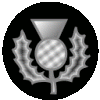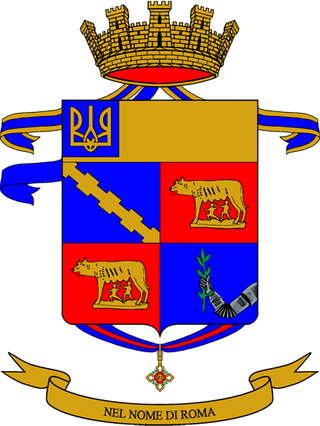Related Research Articles

The 9th (Scottish) Division, was an infantry division of the British Army during the First World War, one of the Kitchener's Army divisions raised from volunteers by Lord Kitchener to serve on the Western Front during the First World War.

The 26th Infantry Regiment is an infantry regiment of the United States Army. Its nickname is "Blue Spaders", taken from the spade-like device on the regiment's distinctive unit insignia. The 26th Infantry Regiment is part of the U.S. Army Regimental System; currently only the 1st Battalion is active and assigned to the 2nd Brigade Combat Team, 101st Airborne Division.

The King's Shropshire Light Infantry (KSLI) was a light infantry regiment of the British Army, formed in the Childers Reforms of 1881, but with antecedents dating back to 1755. It served in the Second Boer War, World War I and World War II. In 1968, the four regiments of the Light Infantry Brigade amalgamated to form The Light Infantry, with the 1st KSLI being redesignated as the 3rd Battalion of the new regiment.

The Massachusetts National Guard is the National Guard component for the Commonwealth of Massachusetts. Founded as the Massachusetts Bay Colonial Militia on December 13, 1636, it contains the oldest units in the United States Army. What is today's Massachusetts National Guard evolved through many different forms. Originally founded as a defensive militia for Puritan colonists in the Massachusetts Bay Colony, the militia evolved into a highly organized and armed fighting force. The Massachusetts militia served as a central organ of the New England revolutionary fighting force during the early American Revolution and a major component in the Continental Army under George Washington.
The 102nd Field Artillery Regiment is an inactive Field Artillery Regiment in the Massachusetts Army National Guard. Originally organized in 1786, the 102nd Field Artillery's predecessor units served in the Civil War, the Spanish–American War, and World War I. Units of the regiment served with the 26th Infantry Division during World War II and the Cold War.

The Wiltshire Regiment was a line infantry regiment of the British Army, formed in 1881 under the Childers Reforms by the amalgamation of the 62nd (Wiltshire) Regiment of Foot and the 99th Duke of Edinburgh's (Lanarkshire) Regiment of Foot.
The 26th Division was an infantry division of the British Army during World War I. The division was created in September 1914 from men volunteering for Lord Kitchener's New Armies and was the last division to be raised under the K3 enlistment scheme. Although the 26th Division began to assemble in September 1914, it was not fully deployed on the Western Front until the following year. In November 1915, the division was redeployed to the Macedonian Front, where it remained until the end of the war.
The 314th Infantry Regiment is an infantry regiment of the U.S. Army first organized in 1917.

The 26th Infantry Division was an infantry division of the United States Army. A major formation of the Massachusetts Army National Guard, it was based in Boston, Massachusetts for most of its history. Today, the division's heritage is carried on by the 26th Maneuver Enhancement Brigade.

The 9th Infantry Division Pasubio was an infantry division of the Royal Italian Army during World War II. The Pasubio was classified as an auto-transportable division, meaning it had some motorized transport, but not enough to move the entire division at once. The division was formed as an infantry division in 1934, reorganized as auto-transportable division in 1939 and mobilized in August 1940. It was named for the battles on Pasubio during World War I. Its 79th Infantry Regiment and 8th Artillery Regiment were made up of men from Verona, while the ranks of the 80th Regiment were filled with men from Mantua. Its I CC.NN. Battalion "Sabauda" was made up of Blackshirt volunteers from Turin.
The 157th Brigade was an infantry brigade of the British Army. The brigade fought in both the First and the Second World Wars, assigned to 52nd (Lowland) Infantry Division.
The Liverpool Brigade, later 165th (Liverpool) Brigade was an infantry brigade of Britain's Volunteer Force that served during World War I with the 55th Division of the British Army. During World War II, again as part of the 55th Infantry Division, the brigade remained in the United Kingdom.

The 35th Brigade was an infantry brigade formation of the British Army that saw active service in both the First and the Second World Wars.

The 37th Brigade was an infantry brigade of the British Army that served in both the First and the Second World Wars.
The 50th Brigade was an infantry brigade formation of the British Army. It was formed during the First World War as part of the New Army, also known as Kitchener's Army. It was assigned to the 17th (Northern) Division and served on the Western Front.
The 199th Brigade was an infantry brigade formation of the British Army that saw active service during the First World War as part of 66th Division. During the Second World War, it was reformed as the 199th Infantry Brigade and served with the 55th Infantry Division until August 1944 when it was redesignated as the 166th Infantry Brigade.
The 176th Brigade was an infantry brigade of the British Army that saw active service in the First World War on the Western Front and disbanded in 1919. The brigade was raised again, now known as 176th Infantry Brigade, shortly prior to the Second World War and fought in the Normandy Campaign before being disbanded in August 1944. In both world wars the brigade was assigned to a 59th Division: the 59th Division during the first, and the 59th (Staffordshire) Infantry Division in the second.
The 144th Infantry Brigade was an infantry brigade of the British Army that saw active service in the First World War and again in the early stages of the Second World War before being reduced to a reserve brigade and remained in the United Kingdom for the rest of the war. In both world wars the brigade served with 48th Division.

The 80th Regiment "Roma" is an active unit of the Italian Army based in Monte Romano in Lazio. The regiment is named for the city of Rome and was part of the Italian Army's infantry arm until 2004, when it became a training unit and was redesignated as a "multi-arms unit" and designated 80th Volunteer Training Regiment "Roma". In December 2023 the regiment became a training support unit at the Monte Romano training range with the new name 80th Regiment "Roma".

The 114th Infantry Regiment "Mantova" is an inactive unit of the Italian Army last based in Tricesimo. The regiment is named for the city of Mantova and part of the Italian Army's infantry arm.
References
- ↑ "26th Division". The Long Long Trail. Retrieved 20 January 2012.